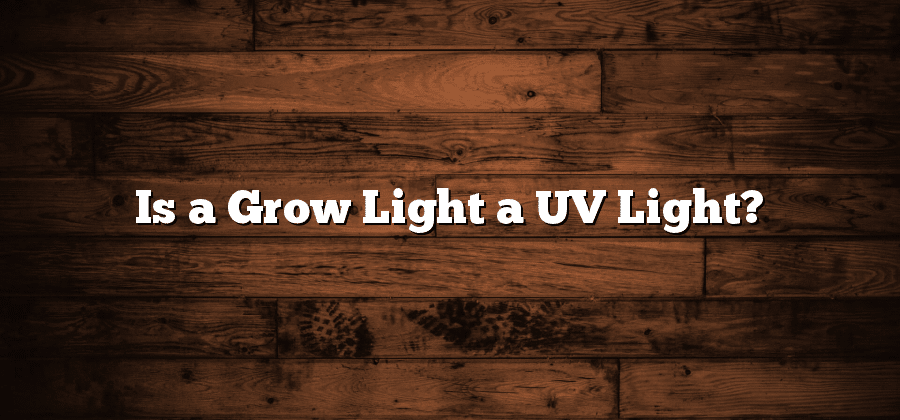Types of Grow Lights
1. LED Grow Lights: LED grow lights are becoming increasingly popular for indoor gardening due to their energy efficiency and longevity. They are known for their ability to emit specific light wavelengths that are most beneficial for plant growth. LED grow lights produce little heat, which minimizes the risk of overheating plants. Additionally, they can be customized to emit specific light spectrums tailored to the needs of different plants during different stages of growth.
2. Fluorescent Grow Lights: Fluorescent grow lights have been used by indoor gardeners for decades. They are a cost-effective option for those starting out in gardening or working with small plants. Fluorescent lights emit a broader spectrum of light that is suitable for a range of plants, making them a versatile option for various gardening purposes. However, it’s important to note that fluorescent grow lights are not as efficient as LED lights and may require more electricity to operate.
The Function of a Grow Light
A grow light is a crucial component in indoor gardening. Its primary function is to provide the necessary light and energy that plants need for photosynthesis. Unlike natural sunlight, which may not always be available or sufficient, a grow light ensures that plants receive a consistent and optimal amount of light throughout their growth cycle.
The function of a grow light goes beyond simply simulating sunlight. It allows growers to have control over the light spectrum, intensity, and duration, which directly impacts the growth and development of plants. With the use of different types of grow lights, such as fluorescent, LED, or HID lights, growers can customize the lighting conditions to meet the specific requirements of different plant species. From providing supplemental light during winter to enabling year-round cultivation in areas with limited sunlight, the function of a grow light is essential in maximizing plant growth and yield.
The Importance of Light Spectrum for Plants
Light spectrum plays a crucial role in the growth and development of plants. Different colors and wavelengths of light have varying effects on plant physiology, influencing processes such as photosynthesis, flowering, and overall plant health. Understanding the importance of light spectrum is key for successful indoor gardening or cultivating plants in controlled environments.
One significant aspect of light spectrum that affects plants is the balance between red and blue light. Red light, found in the 600-700nm wavelength range, is vital for promoting photosynthesis and overall plant growth. It plays a crucial role in stimulating flower and fruit production. On the other hand, blue light, in the 400-500nm range, is essential for promoting vegetative growth and regulating plant height and leaf coloration. Achieving a balance between these two colors is essential to meet the specific requirements of different plants and growth stages.
Understanding UV Light
UV light, also known as ultraviolet light, is a type of electromagnetic radiation that is invisible to the naked eye. It falls in the electromagnetic spectrum between visible light and X-rays. UV light is classified into three main categories: UVA, UVB, and UVC. Each category has a different wavelength and varying levels of energy.
UVA is the longest wavelength of UV light and has the least energy. It is commonly found in sunlight and is responsible for skin aging and tanning. UVB has a shorter wavelength and higher energy than UVA. It is also found in sunlight and is primarily responsible for causing sunburns. UVC, on the other hand, has the shortest wavelength and the highest energy. It is the most harmful type of UV light and is typically absorbed by the Earth’s atmosphere, so it does not reach the surface.
Understanding the different types of UV light is essential, especially when it comes to the health and well-being of plants. While UV light can be harmful to humans and animals in high doses, it plays a crucial role in the growth and development of plants. Certain wavelengths of UV light, particularly UVA and UVB, are known to trigger important photomorphogenic responses in plants. These responses can affect various aspects of a plant’s physiology, including leaf thickness, pigmentation, flower development, and even the production of secondary metabolites. Moreover, exposure to UV light can enhance a plant’s resistance to diseases and pests.
Differences Between UV Light and Grow Lights
UV light and grow lights may seem similar at first glance, as they both contribute to plant growth and development. However, it is crucial to understand the key differences between these two sources of light. Firstly, UV light is a specific type of electromagnetic radiation that falls within the ultraviolet spectrum, whereas grow lights encompass a broader range of light wavelengths. This distinction is important because plants respond differently to various wavelengths of light. UV light plays a more specialized role in plant metabolism and can have both positive and negative effects on plant growth. On the other hand, grow lights provide a more general spectrum of light that is tailored to meet the specific needs of plants throughout their growth cycles.
One significant difference between UV light and grow lights lies in their respective uses and applications. UV light is often utilized as a supplemental light source in controlled environments, such as greenhouses or indoor gardens. It is employed strategically to enhance specific physiological processes in plants, like the production of pigments or the development of certain flavors. In contrast, grow lights are designed to provide a more comprehensive light spectrum that encompasses the entire range of wavelengths needed for photosynthesis. These lights are commonly used as primary light sources, especially in indoor settings where natural sunlight is limited or unavailable. By mimicking the full spectrum of sunlight, grow lights ensure plants have access to the necessary light energy for photosynthesis and overall growth.






